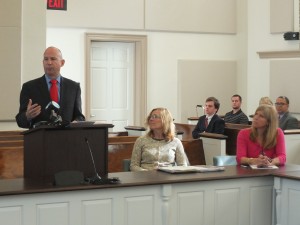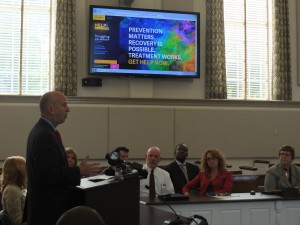Wilmington, DE – Building on ongoing efforts in the state to address the addiction epidemic, Governor Markell was joined by White House officials today to announce federal funding to support a new initiative that will partner law enforcement officers and public health officials to address heroin and prescription drug abuse. (Full release below) The announcement comes less than one week after Governor Markell detailed the state’s priorities for the $4.45 million in new resources provided by the Fiscal Year 2016 budget.
Through his budget proposals of the past two years, the Governor has successfully led efforts to expand access to treatment, including through the opening of a new withdrawal management clinic to serve the southern part of the state, and better match withdrawal services to individual needs, rather than a one-size-fits-all approach.
Today’s announcement complements that work.
________________________________________
Monday, August 17, 2015 CONTACT:
ONDCP Public Affairs: 202-395-6618
Mediainquiry@ondcp.eop.gov
White House Drug Policy Office Funds Delaware High Intensity Drug Trafficking Area
New HIDTA County in Delaware Will Be Part of 15 State Partnership on Heroin
Wilmington, DE – Today, Michael Botticelli, Director of National Drug Control Policy, announced federal funding for Delaware as part of a new law enforcement and public health initiative to address heroin and prescription drug abuse. The funding comes through the High Intensity Drug Trafficking Areas (HIDTA) program, to which New Castle County was designated last year by the White House Office of National Drug Control Policy.
$2.5 million will fund the Heroin Response Strategy, an unprecedented partnership among five regional HIDTA programs — Appalachia, New England, Philadelphia/Camden (of which New Castle County is now a member), New York/New Jersey, and Washington/Baltimore — to address the severe heroin threat facing those communities through public health-public safety partnerships across 15 states.
“The High Intensity Drug Trafficking Areas program helps Federal, state, and local authorities to coordinate drug enforcement operations, support prevention efforts and improve public health and safety,” said Director Botticelli. “The new Heroin Response Strategy demonstrates a strong commitment to address the heroin and prescription opioid epidemic as both a public health and a public safety issue. This Administration will continue to expand community-based efforts to prevent drug use, pursue ‘smart on crime’ approaches to drug enforcement, increase access to treatment, work to reduce overdose deaths, and support the millions of Americans in recovery.”
“While we need to do more to stop the flow of drugs into our cities, suburbs and rural areas, we know we cannot arrest our way out of this health crisis,” said Governor Jack Markell. “In order to truly reduce the number of people and families impacted by addiction, we must convince active users that treatment is available, it does work, and they can recover and thrive. This federal funding will support ongoing efforts in Delaware to address the addiction epidemic and we are grateful for the support of Director Botticelli, along with the tireless advocacy of Delaware’s Congressional delegation.”
“New Castle County is not immune to the heroin epidemic, and this program will help law enforcement combat this problem that affects communities all across the country,” said U.S. Sen. Tom Carper. “It will take an all-hands-on-deck effort to seek out the root causes and fix them. It is through partnerships with law enforcement, the community, and other cities across the country that real change can happen and this program will help to make that change a reality.”
“The addition of New Castle County to the High Intensity Drug Trafficking Areas Program strengthens existing efforts in Delaware,” said U.S. Congressman John Carney. “This investment will help provide much-needed resources for us to better address heroin and prescription drug abuse. I appreciate the Administration’s commitment to ending this epidemic, and I look forward to continuing to work together at the local, regional, and federal level to combat drug abuse and strengthen our communities.”
Background on the High Intensity Drug Trafficking Areas Program
Created by Congress in 1988, the HIDTA program serves as a catalyst for coordination among Federal, state, local, and tribal law enforcement agencies operating in areas determined to be critical drug trafficking regions of the United States. Law enforcement organizations working within HIDTAs assess drug-trafficking issues and design specific initiatives to decrease the production, transportation, distribution, and chronic use of drugs and money laundering. There are currently 28 HIDTAs located in 48 states, as well as in Puerto Rico, the U.S. Virgin Islands, and the District of Columbia.
Today, the Office of National Drug Control Policy announced a total of $13.4 million in funding for HIDTA programs across the country.
Background on the 15-State Heroin Response Strategy:
The Heroin Response Strategy will foster a collaborative network of public health-public safety partnerships to address the heroin/opioid epidemic from multiple perspectives. The Strategy will enhance the efficacy and efficiency of the criminal intelligence process in support of cooperative law enforcement operations. The five HIDTAs will create a 15-state network of experienced, connected law enforcement contacts and leverage these connections and information-gathering capabilities with a strong, complementary, analytical capacity.
The five HIDTAs will select two centrally located Regional Coordinators, one with a public health focus and the other with a public safety focus, who will manage and oversee implementation and operation of the Heroin Response Teams. The Public Health Coordinator will oversee regional reporting of fatal and non-fatal overdose information and issuing of relevant alerts regarding dangerous batches of heroin and other heroin-related threats to health authorities. This will mobilize a rapid public health response to distribute naloxone or expand resources in the affected areas, helping to mitigate the number of overdoses and prevent deaths. The Public Safety Coordinator will oversee execution of public safety goals by ensuring case support is provided where needed and intelligence is being disseminated to relevant law enforcement authorities to enable disruption of the heroin supply.
A heroin and prescription opioid training curriculum will be developed and used to prepare rural and municipal officers and first responders who are inexperienced responding to heroin and prescription opioid-related incidents. To assist communities in coping with this escalating problem, the five HIDTAs will develop Education & Training strategies that will increase awareness of heroin and opiate addiction, create linkages to available prevention and treatment resources in the respective regions, and enable first-responders to know how to report all pertinent lead information developed from seizures and overdose responses.
The Heroin Response Strategy builds upon the successes of the 2014 symposium hosted by the Washington/Baltimore HIDTA. Each year, the five HIDTAs will host two, two-day State of the Region symposia at a jointly nominated HIDTA. These symposia will build additional structure within each respective HIDTA region for the attendees to maintain regular contact and continue their public health-public safety partnerships between symposia. The aim will be to facilitate collaboration between public health and public safety partners within and across jurisdictions, sharing best practices, innovative pilots, and identifying new opportunities to leverage resources.
Background on the Administration’s National Drug Policy
The Obama Administration’s drug policy treats the national drug challenge as a public health issue, not just a criminal justice issue. This approach is built upon the latest scientific research demonstrating that addiction is a chronic disease of the brain that can be successfully prevented and treated, and from which one can recover.
The Administration has directed Federal agencies to expand community-based efforts to prevent drug use before it begins, empower healthcare workers to intervene early at the first signs of a substance use disorder, expand access to treatment for those who need it, support the millions of Americans in recovery, and pursue “smart on crime” approaches to drug enforcement.
For more information about the Office of National Drug Control Policy, visit: www.whitehouse.gov/ondcp
For information on the High Intensity Drug Trafficking Areas (HIDTA) program, visit: www.whitehouse.gov/ondcp/high-intensity-drug-trafficking-areas-program
###

